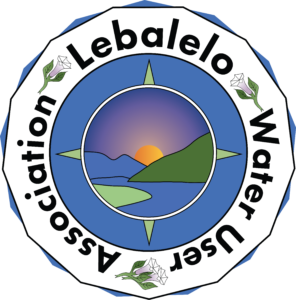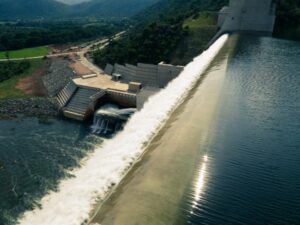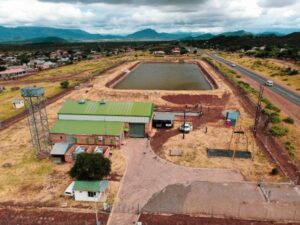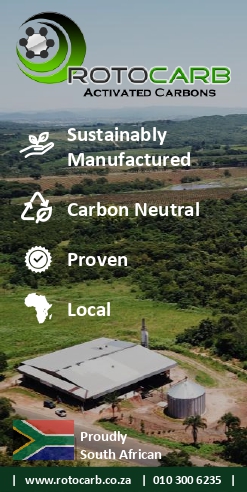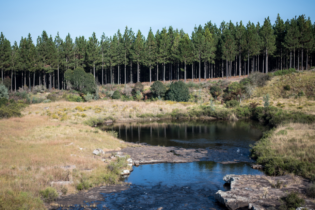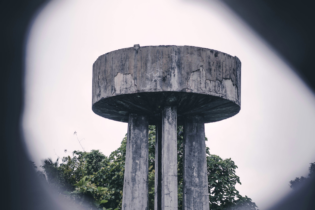from government and private sector stakeholders from mining companies. In an exclusive interview, Bertus Bierman, CEO of LWUA, discusses the Association’s evolution, transformative journey, and future prospects.
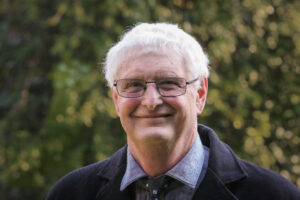 Bertus Bierman, CEO of LWUA
The Bushveld Igneous Complex in the northern parts of South Africa contains some of the richest ore deposits on earth. But many of the mines along the eastern limb of this complex would not exist without the bulk raw water infrastructure that was built and is currently operated by LWUA.
A brief history
This infrastructure – known as the Lebalelo Scheme – includes an abstraction weir on the Olifants River, settling ponds, storage dams, pump stations, reservoirs, and a pipeline that runs from Modubeng to Mototolo Mine. During the building of the scheme, provision was made to ensure the Department of Water and Sanitation (DWS) or any other water services authority (WSA) would be able to abstract raw water for purification and supply 105 villages, demarcated by local government. An agreement was made between the DWS (then DWAF) and the Department of Agriculture, whereby LWUA would be temporarily licensed to use a specified volume of water out of the Olifants River from the Flag Boshielo Dam. This allocation was to be ‘borrowed’ from the non utilised irrigation volume for a period of seven years. During those years, LWUA financed the raising of the Flag Boshielo Dam wall by 5 m to ensure there was an adequate supply of water for the mining industry. They also embarked on building the southern extension of the pipeline – expanding it to 110 km.
Currently, LWUA owns, operates and maintains:
Bertus Bierman, CEO of LWUA
The Bushveld Igneous Complex in the northern parts of South Africa contains some of the richest ore deposits on earth. But many of the mines along the eastern limb of this complex would not exist without the bulk raw water infrastructure that was built and is currently operated by LWUA.
A brief history
This infrastructure – known as the Lebalelo Scheme – includes an abstraction weir on the Olifants River, settling ponds, storage dams, pump stations, reservoirs, and a pipeline that runs from Modubeng to Mototolo Mine. During the building of the scheme, provision was made to ensure the Department of Water and Sanitation (DWS) or any other water services authority (WSA) would be able to abstract raw water for purification and supply 105 villages, demarcated by local government. An agreement was made between the DWS (then DWAF) and the Department of Agriculture, whereby LWUA would be temporarily licensed to use a specified volume of water out of the Olifants River from the Flag Boshielo Dam. This allocation was to be ‘borrowed’ from the non utilised irrigation volume for a period of seven years. During those years, LWUA financed the raising of the Flag Boshielo Dam wall by 5 m to ensure there was an adequate supply of water for the mining industry. They also embarked on building the southern extension of the pipeline – expanding it to 110 km.
Currently, LWUA owns, operates and maintains: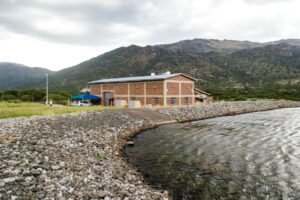 • Havercroft weir, settlement ponds, and storage dams
• Havercroft weir, settlement ponds, and storage dams• five pump stations (Havercroft, Clapham, Spitskop, Dwarsrivier, Borwa)
• two reservoirs (Croyden, Mooihoek)
• 110 km of bulk raw water pipeline. At the time, LWUA’s mandate was very specific: to provide bulk raw water to mines and an offtake for the WSAs serving the surrounding communities. Period of discontent From roughly 2015, there was a negative perception among the communities in the surrounding areas that the mines were taking their water and
giving little back in the form of jobs or opportunities. This dissatisfaction also spilled over towards LWUA. This led to government publishing an intention to
disestablish LWUA and incorporate it into Lepelle Northern Water. During that period, LWUA also suffered damages of over R25 million to its pipeline due to vandalism and theft aimed at halting mining operations. The transformation: ORWRDP and OMMP “This was a pivotal moment, where LWUA started to position itself as an asset to the country with the purpose of improving lives through water. We
created a vision to be a strategic water management partner and catalyst for the creation of sustainable socio-economic development (SED) in the region in which we operate,” states Bierman. During its transformation process, LWUA prepared a proposal to revise government’s Olifants River Water Resources Development Project (ORWRDP), which was conceptualised by the DWS in parallel to the construction of the Lebalelo Scheme to relieve pressure on the overallocated Flag Boshielo Dam and to supply water to Polokwane, Mokopane, and Sekuruwe. “The project was aimed at addressing the water needs of the Middle Olifants Catchment Area in Limpopo. Slow progress was being made due to a lack of funding and expertise. We wanted to propose sharing in 50% of the project’s costs and expand it by providing potable water infrastructure (to a yard connection) to approximately 390 000 people living around the mines. We wanted to include bulk potable water and water reticulation in the scope to improve social harmony in a region where infrastructure development has been very slow during the past decades,” adds Bierman. However, LWUA first had to win over the mining companies with its suggestion, as this would almost double project costs. “Mining companies only need raw water for their operations, but we were proposing treating a portion of that raw water and supplying potable water infrastructure to communities living in the surrounding areas,” explains Bierman. Most of these mines had tried to supply potable water to communities via their own corporate social investment and social labour plan projects. According
to Bierman, this was a difficult and complicated task, as some communities could be supplied by two different mines while other communities were not supplied at all. Furthermore, water treatment/reticulation was not a focus area of these mines and very often had to be outsourced. “The mines eventually gave their consent for Lebalelo to present the idea. At first, the DWS was reluctant, but they have come on board and fully support the move. We are receiving incredible support from government,” says Bierman. “Initially, there was a high level of distrust between the government institutions and mining companies, and both groups had difficulty working together. But LWUA is all about collaboration and there is a lot of common ground shared by the public and private sector. We play a role in linking the public sector with the private sector to pool funds, expertise, community and stakeholder engagement projects, risk sharing, and regulatory support. We then
implement projects to the satisfaction of both parties. There is sometimes a reluctance to give government money due to complex procurement issues and a perceived high level of corruption; however, individual mining companies are too small in size to tackle water security issues in the area alone. This is where LWUA comes in.”
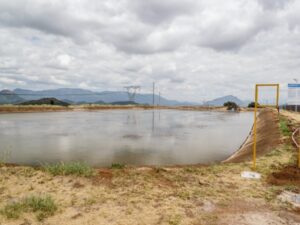 As a result, LWUA developed the Olifants Management Model Programme (OMMP), which is resequencing and accelerating the completion of the ORWRDP to meet revised water needs and reduce capital infrastructure costs. The OMMP is fast-tracking the construction of bulk raw and potable water infrastructure that will supply targeted communities and commercial water users (such as mining companies and industrial users) in Sekhukhune District Municipality and Mogalakwena Local Municipality, while optimising the utilisation of existing dams and infrastructure. In addition, the OMMP will enhance
As a result, LWUA developed the Olifants Management Model Programme (OMMP), which is resequencing and accelerating the completion of the ORWRDP to meet revised water needs and reduce capital infrastructure costs. The OMMP is fast-tracking the construction of bulk raw and potable water infrastructure that will supply targeted communities and commercial water users (such as mining companies and industrial users) in Sekhukhune District Municipality and Mogalakwena Local Municipality, while optimising the utilisation of existing dams and infrastructure. In addition, the OMMP will enhancewater supply to Polokwane Local Municipality. The projects within the OMMP will cost R25 billion. “In terms of commitment from government, so far, the DWS has officially appointed LWUA as implementer of the OMMP, and both an operations and maintenance agreement and a resourcing agreement are about to be signed. We “In terms of commitment from government, so far, the DWS has officially appointed LWUA as implementer of the OMMP, and both an operations and maintenance agreement and a resourcing agreement are about to be signed. We have also received confirmation of Budget Facility for Infrastructure (BFI) funding for Phase 2B and 2B+,” says Bierman. “In the face of significant capital constraints and downward pressure on revenues, it is a ‘big ask’ for mines in the area to sign their part of a R25 billion commitment towards the OMMP. But they see the value, and I believe that all of them will come on board.” Community development The OMMP aims to leverage infrastructure development to strengthen SED across Limpopo. It will unlock the strategic mineral and industrial potential in the specified regions and bring with it much-needed potable water, water security, significant job creation, and SED. “In line with our purpose – improving
lives through water – SED is a core ingredient of any LWUA-funded project going forward. LWUA understands that, to deliver against its mandate, it must prioritise the wellness of the communities in its area of operation. So, 1% of all capital and operational costs of a project are directed towards SED,” he adds.
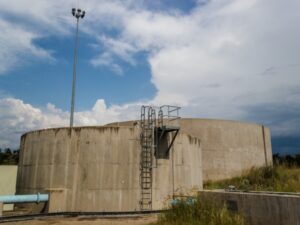 This is anticipated to generate between R170 million and R190 million for SED initiatives within the next five years. The Association plans to further increase SED spend by collaborating with OMMP contractors and consultants, other commercial users, collaboration partners, and donor funders. While water is an essential service for a community, there are other needs like food (agriculture), electricity, schools, roads, and healthcare. LWUA plans to assist communities in all these areas. An example of this work can be seen in LWUA’s school upgrade programme, where the existing infrastructure of selected primary and secondary schools in specific communities within Limpopo is augmented by employing innovative, modular, and low-maintenance solutions.
Last year, Kwata Primary School in Ga-Phala, Limpopo, was fitted with bulk water storage, water-based ablution facilities (and also the upgrading of existing toilets), a revitalised vegetable garden, rainwater harvesting, a wastewater treatment plant, a paved school gathering area, solar power, internet access, and teacher aid tools like interactive whiteboards and training. “Our SED programmes are not a one- or two-year vision; we plan to provide decades of community support. Our ultimate goal is to build a thriving secondary economy in the communities that can survive without the mines,” says Bierman.
Renaming and rebranding
As a newly transformed entity, LWUA will be changing its name to Badirammogo Water User Association. The name Badirammogo is a Sepedi word that means ‘working together’ or ‘collaboration’. The new brand is a symbol that represents both the collaboration between the public and private sectors, and the Association’s expanding role. The elephant in the logo not only symbolises community and social harmony, but also wisdom, stability, loyalty, and determination. Elephants show great care towards their herd, offspring, and elders. The elephant also represents the origin of Lebalelo, with reference to the Olifants Catchment Area.
The water drop is a combination of a inverted triangle on top of a circle, which represents a balance in power, a solid foundation, unity, and longevity. The five drops also represent the Association’s five new values: Safety, Collaboration, Integrity, Empowerment, and Sustainability. While the Minister of Water and Sanitation – Senzo Mchunu – has already approved the name change, some members of the Association still need to sign the amended constitution. Once this is finalised, the name change will be published in the Government Gazette.
“Our Association is a nonprofit, transparent organisation with good governance and an excellent track record in terms of project roll-outs. We have world-class expertise and tools at our disposal. Every drop of water we deliver contributes to job creation, economic growth, and societal well-being. I have no doubt that the dedication of our team – together with the trust of our partners, members, and communities – will continue to propel us forward, as well as enable us to create a sustainable and prosperous future for the communities we serve,” concludes Bierman.
Read here: https://issuu.com/infrastructurenews/docs/wasa_march_april_2024
This is anticipated to generate between R170 million and R190 million for SED initiatives within the next five years. The Association plans to further increase SED spend by collaborating with OMMP contractors and consultants, other commercial users, collaboration partners, and donor funders. While water is an essential service for a community, there are other needs like food (agriculture), electricity, schools, roads, and healthcare. LWUA plans to assist communities in all these areas. An example of this work can be seen in LWUA’s school upgrade programme, where the existing infrastructure of selected primary and secondary schools in specific communities within Limpopo is augmented by employing innovative, modular, and low-maintenance solutions.
Last year, Kwata Primary School in Ga-Phala, Limpopo, was fitted with bulk water storage, water-based ablution facilities (and also the upgrading of existing toilets), a revitalised vegetable garden, rainwater harvesting, a wastewater treatment plant, a paved school gathering area, solar power, internet access, and teacher aid tools like interactive whiteboards and training. “Our SED programmes are not a one- or two-year vision; we plan to provide decades of community support. Our ultimate goal is to build a thriving secondary economy in the communities that can survive without the mines,” says Bierman.
Renaming and rebranding
As a newly transformed entity, LWUA will be changing its name to Badirammogo Water User Association. The name Badirammogo is a Sepedi word that means ‘working together’ or ‘collaboration’. The new brand is a symbol that represents both the collaboration between the public and private sectors, and the Association’s expanding role. The elephant in the logo not only symbolises community and social harmony, but also wisdom, stability, loyalty, and determination. Elephants show great care towards their herd, offspring, and elders. The elephant also represents the origin of Lebalelo, with reference to the Olifants Catchment Area.
The water drop is a combination of a inverted triangle on top of a circle, which represents a balance in power, a solid foundation, unity, and longevity. The five drops also represent the Association’s five new values: Safety, Collaboration, Integrity, Empowerment, and Sustainability. While the Minister of Water and Sanitation – Senzo Mchunu – has already approved the name change, some members of the Association still need to sign the amended constitution. Once this is finalised, the name change will be published in the Government Gazette.
“Our Association is a nonprofit, transparent organisation with good governance and an excellent track record in terms of project roll-outs. We have world-class expertise and tools at our disposal. Every drop of water we deliver contributes to job creation, economic growth, and societal well-being. I have no doubt that the dedication of our team – together with the trust of our partners, members, and communities – will continue to propel us forward, as well as enable us to create a sustainable and prosperous future for the communities we serve,” concludes Bierman.
Read here: https://issuu.com/infrastructurenews/docs/wasa_march_april_2024
